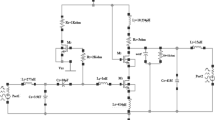Abstract
In this work, a 0.18 μm CMOS LNA is designed which is favorable for a wireless application and the topology used in this design is cascode inductive source degeneration. This proposed LNA is basically designed for ultra-wideband which will be suitable for RF receiver. For an LNA to be in RF receiver, the LNA must be able to amplify very weak signal of – 100 dBm (3.2 uV), must consume very minimum power and lastly, noise generated by LNA must be very small. These requirements are achieved with help of cascode inductive source degeneration topology. This work also presents noise analysis of MOSFET along with LNA’s noise and other parameters analysis. Possible types of topologies are also discussed. The proposed LNA provides a good gain of 19.79 dB, an NF of 2.03 dB, reverse isolation (S12) of − 35.2 dB, input return loss (S11) of − 12.2 dB, and output return loss (S22) of − 12 dB, while consuming 10.8 mW from the supply of 1.8 V. The proposed LNA is simulated in Cadence Spectra using 180 nm UMC technology.






























Similar content being viewed by others
References
Balodi D, Verma A, Govidacharyulu PA (2016) A high gain low noise amplifier design & comparative analysis with other MOS-topologies for Bluetooth applications at 130 nm CMOS. In: Proceedings of IEEE industrial electronics and applications conference, pp 378–383
Bhale VP, Dalal UD (2014) Optimization of CMOS 0.18 μm low noise amplifier for wireless applications. Int J Inf Electron Eng 4(2):92–97
Chiu H-W, Lu S-S, Lin Y-S (2005) A 2.17-dB NF 5-GHz-band monolithic CMOS LNA with 10-mW DC power consumption. IEEE Trans Microw Theory Tech 53(3):813–824
Chu Y, Liao C, Chuang H (2003) 5.7 GHz 0.18/spl mu/m CMOS gain-controlled LNA and mixer for 802.11a WLAN applications. In: Proceedings of IEEE radio frequency integrated circuits symposium, pp 221–224
Feng YuX, Lim WM, Gu J, Sui W (2013) Compact 50–62 GHz current-reused low-noise amplifier with gate-drain transformer feedback. Electron Lett 49(11):720–722
Gatta F et al (2001) A 2-dB noise figure 900-MHz differential CMOS LNA. IEEE J Solid State Circuits 36(10):1444–1452
Guo W, Huang D (2002) The noise and linearity optimization for 1.9 GHz CMOS low noise amplifier. In: Proceedings of IEEE Asia Pacific conference on ASIC, pp 253–257
Han K et al (2005) Complete high-frequency thermal noise modeling of short-channel MOSFETs and design of 5.2-GHz low noise amplifier. IEEE J Solid State Circuits 40(3):726–735
Haraz O (2012) Why do we need ultra-wideband? (1). VLSI Egypt. https://www.vlsiegypt.com/home/?p=518. Accessed 19 Nov 2012
Huang Z-Y, Huang C-C (2007) A CMOS low noise amplifier with RLC-impedance feedback for 3–5 GHz ultra-wideband wireless system. In: Proceedings of IEEE international symposium on integrated circuits, pp 600–603
Ibrahim AB, Othman AR, Husain MN, Johal MS (2012) The cascode and cascaded techniques LNA at 5.8 GHz using T-matching network for WiMAX applications. Int J Comput Theory Eng 4(1):93–97
Jafarnejad R, Jannesaria A, Sobhib J (2017a) Pre-distortion technique to improve linearity of low noise amplifier. Microelectron J 61:95–105
Jafarnejad R, Jannesari A, Sobhi J (2017b) A linear ultra wide band low noise amplifier using pre-distortion technique. Int J Electron Commun 79:172–183
Kumar R, Kumar M, Srivastava VM (2012) Design and noise optimization for an RF low noise amplifier. Int J VLSI Des Commun Syst 3(2):165–173
Kumar R, Devi A, Sarkar A, Talukdar FA (2016) Design of 5.5 GHz linear low noise amplifier using post-distortion technique with body biasing. Microsyst Technol 22(11):2681–2690
Lee TH (1998) The design of CMOS radio-frequency integrated circuits. Cambridge University Press, Cambridge
Liao CH, Chuang HR (2003) A 5.7 GHz 0.18 nm CMOS gain-controlled differential LNA with current reuse for WLAN receiver. IEEE Microw Wirel Compon Lett 13(12):526–528
Meaamar Chye BC, Anh M, Seng YK (2009) A 3 to 8 GHz low noise CMOS amplifier. IEEE Microw Wirel Compon Lett 19(4):245–247
Nejati H, Ragheb T, Nieuwoudt A, Massoud Y (2007) Modeling and design of ultrawideband low noise amplifiers with generalized impedance matching networks. In: Proceedings of IEEE ISCAS, pp 2622–2625
Nejati H, Ragheb T, Massoud Y (2008) Analytical modeling of common-gate low noise amplifiers. In: Proceedings of IEEE ISCAS, pp 888–891
Oluwajobi FI, Wasiu L (2014) Multisim design and simulation of 2.2 GHz LNA for wireless communication. Int J VLSI Des Commun Syst 5(4):65–74
Park B, Choi S, Hong S (2010) A low noise amplifier with tunable interference rejection for 3.1 to 10.6 GHz UWB systems. IEEE Microw Wirel Compon Lett 20(1):40–42
Rastegar H, Ryu J-Y (2015) A broadband low noise amplifier with built-in linearizer in 0.13-mm CMOS process. Microelectron J 46(8):698–705
Rastegar H, Saryazdi S, Hakimi A (2013) A low power and high linearity UWB low noise amplifier (LNA) for 3.1–10.6 GHz wireless applications in 0.13 mm CMOS process. Microelectron J 44(3):201–209
Razavi Behzad (2011) RF microelectronics, 2nd edn. Prentice Hall, New York
Razavi B (2013) Design of analog CMOS integrated circuits. McGraw Hill Education Private Limited, Chennai
Shaeffer DK, Lee TH (1997) A 1.5-V, 1.5-GHz CMOS low noise amplifier. IEEE J Solid State Circuits 32(5):745–759
Singh CL, Baishnab KL, Anandini Ch (2017) Analysis and optimization of noises of an analog circuit via PSO algorithms. Microsyst Technol. https://doi.org/10.1007/s00542-017-3573-8
Wei YL, Jin JD (2009) A low power low noise amplifier for K-band applications. IEEE Microw Wirel Compon Lett 19(2):116–118
Author information
Authors and Affiliations
Corresponding author
Additional information
Publisher's Note
Springer Nature remains neutral with regard to jurisdictional claims in published maps and institutional affiliations.
Rights and permissions
About this article
Cite this article
Anandini, C., Talukdar, F.A., Singh, C.L. et al. Analysis of CMOS 0.18 μm UWB low noise amplifier for wireless application. Microsyst Technol 26, 3243–3257 (2020). https://doi.org/10.1007/s00542-018-4005-0
Received:
Accepted:
Published:
Issue Date:
DOI: https://doi.org/10.1007/s00542-018-4005-0




